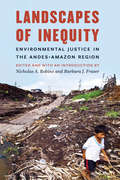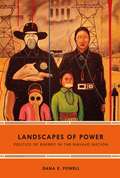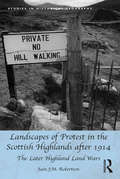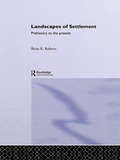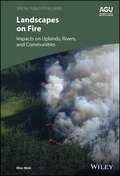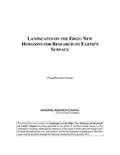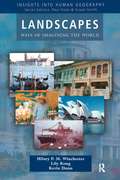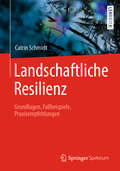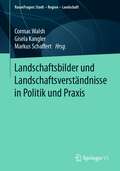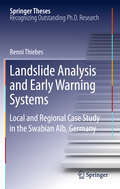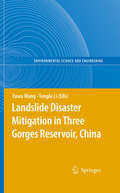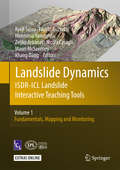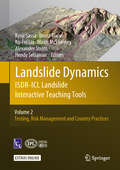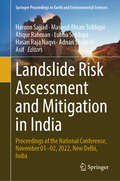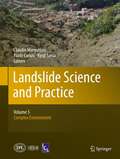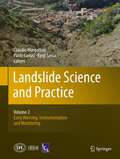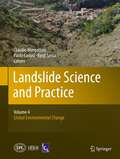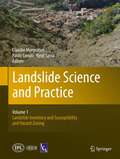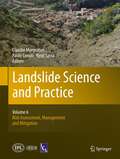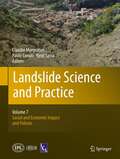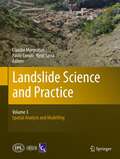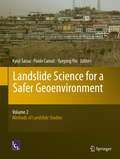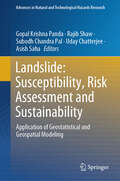- Table View
- List View
Landscapes of Inequity: Environmental Justice in the Andes-Amazon Region
by Nicholas A. Robins Barbara J. FraserThe natural wealth of the Amazon and Andes has long attracted fortune seekers, from explorers, farmers, and gold panners to multimillion-dollar mining, oil and gas, and timber operations. Modern demands for commodities have given rise to new development schemes, including hydroelectric dams, open cast mines, and industrial agricultural operations. The history of human habitation in this region is intimately tied to its rich biodiversity, and the Amazon basin is home to scores of indigenous groups, many of whom have populations so small that their cultural and physical survival is endangered.Landscapes of Inequity explores the debate over rights to and use of resources and addresses fundamental questions that inform the debate in the western Amazon basin, from the Andes Mountains to the tropical lowlands. Beginning with an examination of the divergent conceptual interpretations of environmental justice, the volume explores the issue from two interlocking perspectives: of indigenous peoples and of economic development in a global economy. The volume concludes by examining the efficacy of laws and policies concerning the environment in the region, the viability and range of judicial recourse, and future directions in the field of environmental justice.
Landscapes of Power: Politics of Energy in the Navajo Nation
by Dana E. PowellIn Landscapes of Power Dana E. Powell examines the rise and fall of the controversial Desert Rock Power Plant initiative in New Mexico to trace the political conflicts surrounding Native sovereignty and contemporary energy development on Navajo (Diné) Nation land. Powell's historical and ethnographic account shows how the coal-fired power plant project's defeat provided the basis for redefining the legacies of colonialism, mineral extraction, and environmentalism. Examining the labor of activists, artists, politicians, elders, technicians, and others, Powell emphasizes the generative potential of Navajo resistance to articulate a vision of autonomy in the face of twenty-first-century colonial conditions. Ultimately, Powell situates local Navajo struggles over energy technology and infrastructure within broader sociocultural life, debates over global climate change, and tribal, federal, and global politics of extraction.
Landscapes of Protest in the Scottish Highlands after 1914: The Later Highland Land Wars (Studies In Historical Geography Ser.)
by Iain J.M. RobertsonIn November 1918, the implementation of agrarian change in the Scottish Highlands threatened another wave of unemployment and eviction for the land-working population, which led to widespread and varied social protest. Those who had been away on war service (and their families) faced returning to exactly the same social and economic conditions in the Scottish Highlands they had hoped they had left behind in the struggle to make ’a land fit for heroes’. Widespread and varied social protest rapidly followed. It argues that, previously, there has been a failure to capture fully the geography, chronology typology and rate of occurrence of these events. The book not only offers new insights and a greater understanding of what was happening in the Highlands in this period, but illustrates how a range of forms of protest were used which demand attention, not least for the fact that these events, unlike most of the earlier Land Wars period, were successful. There are functioning townships in the Highlands today that owe their existence to the land invasions of the 1920s. The book innovatively concentrates on formulating explanation and interpretation from within and looks to the crofting landscape as base, means and motive to disturbance and interpretation. It proposes that protest is much more convincingly understood as an expression of environmental ethics from 'the bottom up' coming increasingly into conflict with conservationist views expressed from 'the top down' It focuses on individual case studies in order to engage more convincingly with an important evidential base - that of popular memory of land disturbances - and to adopt a frame and lens through which to explore the fluid and contingent nature of protest performances. Based upon the belief that in the study of landscapes of social protest the old shibboleth of space as solely passive setting and symbolic register is no longer tenable is paid here to nature/culture interactions, to vernacular ecological b
Landscapes of Settlement: Prehistory to the Present (British Archaeological Reports International Ser.)
by Brian RobertsFirst published in 2004. Routledge is an imprint of Taylor & Francis, an informa company.
Landscapes of the Anthropocene with Google Earth
by Andrew GoudieThis book considers the meaning of the term, considers the value and characteristics of Google Earth, and discusses the main driving forces of landscape change. Google Earth provides a means whereby one can identify changes in the landscapes of Earth over recent decades. This has been a time of great human activity, and landscapes have been transformed as a result of such factors as land use and land-cover change, climate change, the intensive harnessing of new energy sources, population pressures, and globalization. Many geologists now believe that the whole Earth System is being changed and that there is thus a need to introduce the concept of the Anthropocene. It then looks at specific landscape types, including rivers, coasts, lakes, deserts, tundra, and glaciers.
Landscapes on Fire: Impacts on Uplands, Rivers, and Communities (Special Publications)
by Ellen WohlExplores the effects of wildfires on land, water, vegetation, wildlife, and humans Across the world, wildfires are increasing in frequency, extent, and severity, driven by changes in land use and climate. After the immediate hazards of fire and smoke have passed, landscapes and ecosystems can be left altered for decades. Landscapes on Fire: Impacts on Uplands, Rivers, and Communities presents an overview of wildfires and their after-effects on different parts of the natural, biological, and human landscape, bringing together perspectives from different disciplines. Volume highlights include: Causes, mechanics, and patterns of wildfire Effects of fire on uplands and river networks Predicting and mitigating fire-related hazards Projected trends in wildfire patterns and effects due to climate change Case studies from across the world The American Geophysical Union promotes discovery in Earth and space science for the benefit of humanity. Its publications disseminate scientific knowledge and provide resources for researchers, students, and professionals.
Landscapes on the Edge: New Horizons for Research on Earth's Surface
by National Research Council of the National AcademiesDuring geologic spans of time, Earth's shifting tectonic plates, atmosphere, freezing water, thawing ice, flowing rivers, and evolving life have shaped Earth's surface features. The resulting hills, mountains, valleys, and plains shelter ecosystems that interact with all life and provide a record of Earth surface processes that extend back through Earth's history. Despite rapidly growing scientific knowledge of Earth surface interactions, and the increasing availability of new monitoring technologies, there is still little understanding of how these processes generate and degrade landscapes. Landscapes on the Edge identifies nine grand challenges in this emerging field of study and proposes four high-priority research initiatives. The book poses questions about how our planet's past can tell us about its future, how landscapes record climate and tectonics, and how Earth surface science can contribute to developing a sustainable living surface for future generations.
Landscapes: Ways of Imagining the World (Insights Into Human Geography)
by Hilary P.M. WinchesterFirst published in 2003. Routledge is an imprint of Taylor & Francis, an informa company.
Landschaftliche Resilienz: Grundlagen, Fallbeispiele, Praxisempfehlungen
by Catrin SchmidtDieses Buch erklärt was die Resilienz von Landschaften ausmacht. Warum können sich manche Landschaften von Störereignissen oder Krisen rasch wieder erholen, während andere auf absehbare Zeit gänzlich aus der Balance gebracht werden? Die Autorin begibt sich auf die Suche nach den Einflussfaktoren und Bedingungsgefügen landschaftlicher Resilienz und wertet dazu nicht nur den aktuellen Stand der Fachdiskussion aus, sondern erkundet rund um den Globus Landschaften, die kontrastreicher nicht sein könnten: von ariden Agrarlandschaften bis zu borealen Waldlandschaften, von Atollen bis zu Salzlandschaften, von Terrassenlandschaften bis hin zu Städten. Ebenso vielfältig wie die Landschaftstypen sind die betrachteten Faktoren, die Landschaften unter Stress setzen können. So unterschiedlich die Fallbeispiele aber im Einzelnen auch sind, ihr faszinierendes Mosaik zeigt zugleich, dass es übergreifende Prinzipien gibt, mit denen sich die Widerstandsfähigkeit von Landschaften gezielt erhöhen lässt, so dass Landschaften aus Krisen möglichst nicht geschwächt, sondern gestärkt hervorgehen.
Landschaftsbilder und Landschaftsverständnisse in Politik und Praxis (RaumFragen: Stadt – Region – Landschaft)
by Cormac Walsh Gisela Kangler Markus SchaffertDie Governance von Raum, Natur, Umwelt und Kultur ist von unterschiedlichen Landschaftsbildern und Verständnissen von Landschaft geprägt. So haben Bürger*innen, Grundbesitzer*innen, Landschaftsarchitekt*innen, Landbewirtschafter*innen, Naturschützer*innen, Raumplaner*innen, Touristiker*innen eine Reihe von durchaus verschiedenen Lesarten von Landschaft: Natur- oder Kulturlandschaft, genutzte oder verwilderte Landschaft, Landschaft als Privat- oder Gemeinschaftsgut, Landschaft als Schutzgut oder Ressource, Landschaft als physischer Raum oder gesellschaftliches Konstrukt und andere. Die Beiträge in diesem Band machen deutlich, wie vielschichtig sich Landschaftsbilder und Landschaftsverständnisse heute erweisen und wie mannigfaltig die methodischen Entwicklungen und Projekte sind, mit denen wissenschaftliche Erkenntnisse in die Praxis der Governance-Prozesse eingebracht werden.
Landslide Analysis and Early Warning Systems
by Benni ThiebesRecent landslide events demonstrate the need to improve landslide forecasting and early warning capabilities in order to reduce related risks and protect human lives. In this thesis, local and regional investigations were carried out to analyse landslide characteristics in the Swabian Alb region, and to develop prototypic landslide early warning systems. In the local study area, an extensive hydrological and slope movement monitoring system was installed on a seasonally reactivated landslide body located in Lichtenstein- Unterhausen. Monitoring data was analysed to assess the influence of rainfall and snow-melt on groundwater conditions, and the initiation of slope movements. The coupled hydrology-slope stability model CHASM was applied to detect areas most prone to slope failures, and to simulate slope stability using a variety of input data. Subsequently, CHASM was refined and two web-based applications were developed: a technical early warning system to constantly simulate slope stability integrating rainfall measurements, hydrological monitoring data and weather forecasts; and a decision-support system allowing for quick calculation of stability for freely selectable slope profiles. On the regional scale, available landslide inventory data were analysed for their use in evaluation of rainfall thresholds proposed in other studies. Adequate landslide events were selected and their triggering rainfall and snow-melting conditions were compared to intensity-duration and cumulative thresholds. Based on the results, a regional landslide early warning system was developed and implemented as a webbased application. Both, the local and the regional landslide early warning systems are part of a holistic and integrative early warning chain developed by the ILEWS project, and could easily be transferred to other landslide prone areas.
Landslide Disaster Mitigation in Three Gorges Reservoir, China
by Tonglu Li Fawu WangThis book presents the research results on landslide disaster mitigation in Three Gorges Reservoir, China. It consists of three parts. (1) Regional properties of landslides in this area, (2) Case studies about some typical landslides, and (3) New methodologies applied in this area. It provides useful information to academics, practitioners, and university students working on landslide disaster mitigation, especially for large engineering projects. This book can also be used as an information source for geo-hazards in the Three Gorges Reservoir Area.
Landslide Dynamics: ISDR-ICL Landslide Interactive Teaching Tools
by Kyoji Sassa Fausto Guzzetti Hiromitsu Yamagishi Željko Arbanas Nicola Casagli Mauri McSaveney Khang DangThis interactive book presents comprehensive information on the fundamentals of landslide types and dynamics, while also providing a set of PPT, PDF, and text tools for education and capacity development. As the core activity of the Sendai Partnerships, the International Consortium of Landslides has created this two-volume work, which will be regularly updated and improved over the coming years, based on responses from users and lessons learned during its application.
Landslide Dynamics: Testing, Risk Management And Country Practice
by Alexander Strom Kyoji Sassa Binod Tiwari Mauri McSaveney Ko-Fei Liu Hendy SetiawanThis interactive book presents comprehensive information on the fundamentals of landslide types and dynamics, while also providing a set of PPT, PDF, and text tools for education and capacity development. As the core activity of the Sendai Partnerships, the International Consortium of Landslides has created this two-volume work, which will be regularly updated and improved over the coming years, based on responses from users and lessons learned during its application.
Landslide Ecology
by Lawrence R. Walker Aaron B. ShielsDespite their often dangerous and unpredictable nature, landslides provide fascinating templates for studying how soil organisms, plants and animals respond to such destruction. The emerging field of landslide ecology helps us understand these responses, aiding slope stabilisation and restoration and contributing to the progress made in geological approaches to landslide prediction and mitigation. Summarising the growing body of literature on the ecological consequences of landslides, this book provides a framework for the promotion of ecological tools in predicting, stabilising, and restoring biodiversity to landslide scars at both local and landscape scales. It explores nutrient cycling; soil development; and how soil organisms disperse, colonise and interact in what is often an inhospitable environment. Recognising the role that these processes play in providing solutions to the problem of unstable slopes, the authors present ecological approaches as useful, economical and resilient supplements to landslide management.
Landslide Risk Assessment and Mitigation in India: Proceedings of the National Conference, November 01-02, 2022, New Delhi, India (Springer Proceedings in Earth and Environmental Sciences)
by Haroon Sajjad Atiqur Rahman Lubna Siddiqui Masood Ahsan Siddiqui Hasan Raja Naqvi Adnan Shakeel AsifThis book focuses on landslide hazard mapping, identification of site-specific drivers of landslide occurrence, and assessment of landslide susceptibility, vulnerability, risk and mitigation using advanced techniques and approaches. The book encompasses the use of geospatial technologies, artificial intelligence, machine learning algorithms, and advanced statistical models to explore multi-dimensionality of landslide hazard. The book is a synthesis of research papers presented at the National Conference on Landslide Risk Assessment and Mitigation in India, organized by the Department of Geography, Jamia Millia Islamia, New Delhi, India, 01–02 November 2022. The book is organized into four parts made up of 21 chapters. Part I deals with landslide hazard mapping. Part II covers landslide susceptibility mapping and assessment. Part III evaluates landslide risk. Finally, Part IV presents multi-disciplinary approach and holistic mechanism to devise landslide mitigation strategies. The chapters help better understand the intertwined physical processes, causes of landslides, potential risk factors, movement characteristics, and role of engineering and technology to minimize upcoming human, physical and economic losses. The book is a valuable resource for researchers, academicians, stakeholders, and policy makers.
Landslide Science and Practice: Complex Environment
by Claudio Margottini Kyoji Sassa Paolo CanutiThis book contains peer-reviewed papers from the Second World Landslide Forum, organised by the International Consortium on Landslides (ICL), that took place in September 2011. The entire material from the conference has been split into seven volumes, this one is the fifth: 1. Landslide Inventory and Susceptibility and Hazard Zoning, 2. Early Warning, Instrumentation and Monitoring, 3. Spatial Analysis and Modelling, 4. Global Environmental Change, 5. Complex Environment, 6. Risk Assessment, Management and Mitigation, 7. Social and Economic Impact and Policies.
Landslide Science and Practice: Early Warning, Instrumentation and Monitoring
by Claudio Margottini Kyoji Sassa Paolo CanutiThis book contains peer-reviewed papers from the Second World Landslide Forum, organised by the International Consortium on Landslides (ICL), that took place in September 2011. The entire material from the conference has been split into seven volumes, this one is the second: 1. Landslide Inventory and Susceptibility and Hazard Zoning, 2. Early Warning, Instrumentation and Monitoring, 3. Spatial Analysis and Modelling, 4. Global Environmental Change, 5. Complex Environment, 6. Risk Assessment, Management and Mitigation, 7. Social and Economic Impact and Policies.
Landslide Science and Practice: Global Environmental Change
by Claudio Margottini Kyoji Sassa Paolo CanutiThis book contains peer-reviewed papers from the Second World Landslide Forum, organised by the International Consortium on Landslides (ICL), that took place in September 2011. The entire material from the conference has been split into seven volumes, this one is the fourth: 1. Landslide Inventory and Susceptibility and Hazard Zoning, 2. Early Warning, Instrumentation and Monitoring, 3. Spatial Analysis and Modelling, 4. Global Environmental Change, 5. Complex Environment, 6. Risk Assessment, Management and Mitigation, 7. Social and Economic Impact and Policies.
Landslide Science and Practice: Landslide Inventory and Susceptibility and Hazard Zoning
by Claudio Margottini Kyoji Sassa Paolo CanutiThis book contains peer-reviewed papers from the Second World Landslide Forum, organised by the International Consortium on Landslides (ICL), that took place in September 2011. The entire material from the conference has been split into seven volumes, this one is the first: 1. Landslide Inventory and Susceptibility and Hazard Zoning, 2. Early Warning, Instrumentation and Monitoring, 3. Spatial Analysis and Modelling, 4. Global Environmental Change, 5. Complex Environment, 6. Risk Assessment, Management and Mitigation, 7. Social and Economic Impact and Policies.
Landslide Science and Practice: Risk Assessment, Management and Mitigation
by Claudio Margottini Kyoji Sassa Paolo CanutiThis book contains peer-reviewed papers from the Second World Landslide Forum, organised by the International Consortium on Landslides (ICL), that took place in September 2011. The entire material from the conference has been split into seven volumes, this one is the sixth: 1. Landslide Inventory and Susceptibility and Hazard Zoning, 2. Early Warning, Instrumentation and Monitoring, 3. Spatial Analysis and Modelling, 4. Global Environmental Change, 5. Complex Environment, 6. Risk Assessment, Management and Mitigation, 7. Social and Economic Impact and Policies.
Landslide Science and Practice: Social and Economic Impact and Policies
by Claudio Margottini Kyoji Sassa Paolo CanutiThis book contains peer-reviewed papers from the Second World Landslide Forum, organised by the International Consortium on Landslides (ICL), that took place in September 2011. The entire material from the conference has been split into seven volumes, this one is the seventh: 1. Landslide Inventory and Susceptibility and Hazard Zoning, 2. Early Warning, Instrumentation and Monitoring, 3. Spatial Analysis and Modelling, 4. Global Environmental Change, 5. Complex Environment, 6. Risk Assessment, Management and Mitigation, 7. Social and Economic Impact and Policies.
Landslide Science and Practice: Spatial Analysis and Modelling
by Claudio Margottini Kyoji Sassa Paolo CanutiThis book contains peer-reviewed papers from the Second World Landslide Forum, organised by the International Consortium on Landslides (ICL), that took place in September 2011. The entire material from the conference has been split into seven volumes, this one is the seventh: 1. Landslide Inventory and Susceptibility and Hazard Zoning, 2. Early Warning, Instrumentation and Monitoring, 3. Spatial Analysis and Modelling, 4. Global Environmental Change, 5. Complex Environment, 6. Risk Assessment, Management and Mitigation, 7. Social and Economic Impact and Policies.
Landslide Science for a Safer Geoenvironment
by Kyoji Sassa Paolo Canuti Yueping YinThis volume contains peer-reviewed papers from the Third World Landslide Forum organized by the International Consortium on Landslides (ICL) in June 2014. The complete collection of papers from the Forum is published in three full-color volumes and one mono-color volume.
Landslide: Application of Geostatistical and Geospatial Modeling (Advances in Natural and Technological Hazards Research #52)
by Rajib Shaw Uday Chatterjee Subodh Chandra Pal Gopal Krishna Panda Asish SahaThe book illustrates a geospatial and geostatistical approach to data analysis, modeling, risk assessment, and visualization, as well as landslide hazard management in the hilly region. This book investigates cutting-edge methodologies based on open source software and R statistical programming and modeling in current decision-making procedures, with a particular emphasis on recent advances in data mining techniques and robust modeling in torrential rainfall and earthquake induced landslide hazard.
